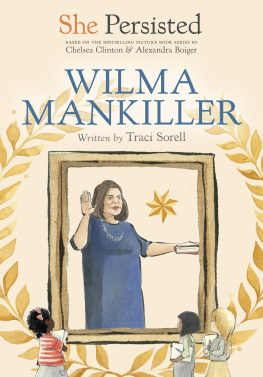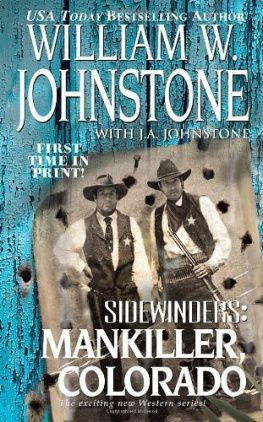Wilma Mankiller - Mankiller: A Chief and Her People
Here you can read online Wilma Mankiller - Mankiller: A Chief and Her People full text of the book (entire story) in english for free. Download pdf and epub, get meaning, cover and reviews about this ebook. year: 1999, publisher: St. Martin’s Griffin, genre: Non-fiction / History. Description of the work, (preface) as well as reviews are available. Best literature library LitArk.com created for fans of good reading and offers a wide selection of genres:
Romance novel
Science fiction
Adventure
Detective
Science
History
Home and family
Prose
Art
Politics
Computer
Non-fiction
Religion
Business
Children
Humor
Choose a favorite category and find really read worthwhile books. Enjoy immersion in the world of imagination, feel the emotions of the characters or learn something new for yourself, make an fascinating discovery.

- Book:Mankiller: A Chief and Her People
- Author:
- Publisher:St. Martin’s Griffin
- Genre:
- Year:1999
- Rating:4 / 5
- Favourites:Add to favourites
- Your mark:
- 80
- 1
- 2
- 3
- 4
- 5
Mankiller: A Chief and Her People: summary, description and annotation
We offer to read an annotation, description, summary or preface (depends on what the author of the book "Mankiller: A Chief and Her People" wrote himself). If you haven't found the necessary information about the book — write in the comments, we will try to find it.
Mankiller: A Chief and Her People — read online for free the complete book (whole text) full work
Below is the text of the book, divided by pages. System saving the place of the last page read, allows you to conveniently read the book "Mankiller: A Chief and Her People" online for free, without having to search again every time where you left off. Put a bookmark, and you can go to the page where you finished reading at any time.
Font size:
Interval:
Bookmark:


The author and publisher have provided this e-book to you for your personal use only. You may not make this e-book publicly available in any way. Copyright infringement is against the law. If you believe the copy of this e-book you are reading infringes on the authors copyright, please notify the publisher at: us.macmillanusa.com/piracy.
This book is dedicated to my brother Louis Donald Mankiller, who gave up much of his youth to feed and clothe his siblings. Then in 1990, he donated a kidney to me, enabling me to continue with my life and work in good health.
My acknowledgment goes to all Cherokee people past, present, and future, especially the women, who have always tried to keep harmony and balance in our world.
There are many people who need to be recognized for helping with this book. It was a team effort. I will start with Charlie Soap, without whose support I would never have been elected chief, and without whose love my life would have taken a very different path.
My appreciation goes to Robert Conley for helping me to conceptualize a book that would include aspects of my life as well as Cherokee history. I want to thank my family, all of whom provided information for the book, but especially my mother, Clara Irene Sitton Mankiller, and my daughter Gina. She typed all the transcripts from the sessions with Michael Wallis, as well as countless pages of stories, commentary, and editorial notes. Special accolades also to my sister Frieda Mankiller Mullins, Lee Fleming, and Linda Vann for their help with genealogical research; to Bob Friedman and Kristina Kiehl for the equipment to do this work; and to Lynn Howard, Lisa Finley, Sammy Still, and Nita Cochran for help with photos.
Finally, I want to thank my co-writer, Michael Wallis, for his great work on this book; St. Martins editor Robert Weil for his wisdom and unequivocal support of this project; Hazel Rowena Mills, a stellar copy editor and unsung hero of this book project; and Dr. Duane H. King, of the National Museum of the American Indian, Smithsonian Institution, for his review and comments. And lastly, my love and appreciation to Gloria Steinem for suggesting the format for this book.
WILMA MANKILLER
I will be forever grateful to Wilma Mankiller for asking me to share in the telling of her life story and the story of the Cherokee people. I first met Wilma in 1982, and since then, she and her husband, Charlie Soap, have become friends with my wife, Suzanne Fitzgerald Wallis, and me. I was honored and pleased when Wilma met with Robert Weil, our superb editor at St. Martins Press, and suggested that I act as her collaborator for this important book.
From the very beginninglong before the first word was writtenWilma and I were in complete agreement with Robert that this book should be not only the story of Wilmas life to date, but also should convey at least part of the story of her people and their rich history and heritage. The writing of the work was a true collaboration in every sense of the word. I will always cherish the memory of those long sessions spent at Wilmas home as we wove the fabric and fiber that make up the story of this remarkable womans life.
Many people and many sources of information were of great help during the researching and writing. My appreciation goes to all those sources who preferred to remain anonymous. Countless friends and family members, librarians, researchers, and others also deserve my everlasting gratitude for contributions to this books development.
I am thankful that despite the many blunders I have made during the course of my life, I had enough good sense to connect with Suzanne, my wife and best friend. Suzannes continued belief in me and in my work as a writer sustains me through all the moments of doubt and despair that seem to go with the job.
Many thanks also go to Dixie Haas Dooley for her diligent research and administrative assistance, as well as her encouragement and suggestions. Dixies early and enthusiastic support for this book, along with her creative contributions, did not go unnoticed. Appreciation goes to Dr. Lydia Wyckoff for her consistent insight, invaluable guidance, and her lasting friendship. Special thanks to Allen Strider, Oklahomas consummate native son, for always being there.
Hazel Rowena Mills is undoubtedly the best copy editor drawing breath. That is the opinion of Wilma Mankiller and Michael Wallis or anyone else who has had the pleasure of working with Rowena. This book benefits from Rowenas deft touch. Her superior editorial prints are throughout the pages. A standing ovation to you, Rowena.
Robert Weil, our hardworking editor at St. Martins Press, has guided this project since its inception in Chief Mankillers office. From the start, he did his level best to see that the book we all hoped for became a reality. Our heartfelt thanks to you, Bob. As an editorial architect, you are without equal.
Kudos as well to Becky Koh, the assistant editor, who never failed to respond to cries for help and to provide answers and counsel. Thanks to others at St. Martins Press, including Twisne Fan, Stephanie Schwartz, Henry Yee, Judy Stagnitto, Claudia Riemer, Karen Burke, and Barbara Andrews.
Finally, my gratitude to the feline duo of Beatrice and Molly, who clocked in long hours of pleasure and pain with me at the word processor.
MICHAEL WALLIS
This book is more than the story of Wilma Mankiller. It is also the extraordinary story of the Cherokee people and their indomitable courage. The chapters of this book weave together the story of one Cherokee woman with the history of all the people of the Cherokee Nation, much as traditional Cherokee stories weave together the unbroken threads of tribal history, wisdom, and culture preserved by each generation.
To honor the eternal voices of all Cherokee storytellers and oral historians, we have used a traditional Cherokee story to begin each of the thirteen chapters in this book. We feel that the untarnished power and wisdom of these stories speak directly from the heart of all that is Cherokee.
Dawn arrives in the countryside of northeastern Oklahoma, warm and familiar like an old pal whos come calling. Sunlight seeps through stands of oak, sycamore, and dogwood, then melts as slowly as country butter over thickets of sumac, sassafras, and persimmon. Stalks of soft light reach the weeds and vines clinging to the sagging wire fences. The rays inch across the garden, and finally the frame house in the clearing is streaked with gold. Inside, the aroma of coffee and biscuits mixes with radio news and morning murmurs.
Before too long the front door slowly opens and Wilma Mankillerthe woman of the houseemerges. She is barefoot and wears a brightly colored dress. Her dark hair is still damp from a morning shampoo. She sits on a kitchen chair on the narrow porch and sips a mug of coffee. A murder of mischievous crows, dancing like ebony marionettes, scolds from the nearby trees. In the distance the voices of jays, mockingbirds, and wrens deliver a chorus. Soon hawks will begin patrolling the sky.
Walkingsticks appear, seemingly from nowhere, to dine on tender leaves. The spindly insects resemble twigs as they slowly creep over the porch and the railing. Some crawl up the chair. One moves across Man-killers legs, but she doesnt appear to notice or care. Another moves across her shoulders and starts up her hair, but Mankiller gently shakes the creature free. She knows the walkingsticks are not interested in her, but merely want to reach the redbud tree growing next to the porch.
Font size:
Interval:
Bookmark:
Similar books «Mankiller: A Chief and Her People»
Look at similar books to Mankiller: A Chief and Her People. We have selected literature similar in name and meaning in the hope of providing readers with more options to find new, interesting, not yet read works.
Discussion, reviews of the book Mankiller: A Chief and Her People and just readers' own opinions. Leave your comments, write what you think about the work, its meaning or the main characters. Specify what exactly you liked and what you didn't like, and why you think so.










